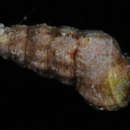Comprehensive Description
provided by Smithsonian Contributions to Zoology
Cerithium rostratum Sowerby, 1855
?Cerithium ravidum Philippi, 1849:3, pl. 1: fig. g [type not found, no locality given; nomen dubium].
Cerithium rostratum Sowerby, 1855:861, pl. 158: fig. 104 [lectotype: BMNH 19861741, 3 paralectotypes, BMNH 198617424; type locality: Philippines, herein restricted to Cebu; 18.1 mm × 6.18 mm]; 1865, pl. 14: fig. 95.—Tryon. 1887:130, pl. 23: figs. 90, 91.—Kobelt, 1898211,pl. 37: figs. 8, 9.— Hedley, 1899:430.—Schepman, 1909:159.
Ctrithium gracile Pease, 1861:432 [lectotype: BMNH 1961173 and 3 paralectotypes, BMNH 19651174; type locality: Sandwich Islands. 12.0 mm × 4.8 mm; not Cerithium gracile Lamarck, 1804].—Tryon, 1887:173, pl. 36: figs. 50, 51.—Kay, 1965:45, pl. 5: figs. 5, 6.
Cerithium amabile Bayle, 1880:246 [new name for Cerithium gracile Pease, 1861; incorrectly attributed to Sowerby by Bayle].
Cerithium albovaricosum E.A. Smith, 1884:501 [new name for Cerithium gracile Pease, 1861].
Colina (Ischnocerithium) rostrata (Sowerby).—Thiele, 1929:212.—Wenz, 1940:758, fig. 2199.—Ladd, 1972:32, pl. 4: fig. 17.
Cerithium (Ptychocerithium) rostratum Sowerby.—Abrard, 1942:60 pl. 6: fig. 27.
Cerithium (Ischnocerithium) rostratum (Sowerby).—Cemohorsky, 1972:66, pl. 14: fig. 6.
DESCRIPTION.—Shell (Figures 114, 115): Shell thin, elongate, slender, fusiform, comprising 12–16 angulate whorls and reaching 22.9 mm length and 7.8 mm width. Protoconch 3 whorls (Figure 115F): protoconch 1 smooth, 0.5 whorls; protoconch 2, 3 whorls, elaborately sculptured with two centrally placed spiral threads and strong pre- and subsutural, colabral, axial ribs; interspace between spiral threads with tiny chevron-like ribs. Deep sinusigeral sinus at protoconch lip. Early teleoconch (Figure 115K) with broad, sloping subsutural ramp and sculptured with 2 or 3 spiral cords. Adult teleoconch whorls acutely angulate to moderately inflated, sculptured with wide to slender axial ribs crossed by numerous small spiral threads sometimes forming tiny beads at cross-over points. Varices randomly placed. Penultimate whorl with 0–25 axial ribs and 5–9 thin, spiral cords. Suture deeply impressed, straight. Body whorl elongate, weakly excavated at base, sloping into elongate, tightly constricted, straight, anterior siphonal canal. Body whorl sculptured with large varix opposite outer lip of aperture, numerous fine spiral threads and striae, sometimes beaded, and with main spiral cord at edge of long, sloping, basal excavation; axial ribs usually absent. Aperture ovate, about one-fourth the shell length. Columella concave with thin columellar callus. Anal canal weak, bordered by small, parietal, columellar plait Outer lip strongly convex, thin, weakly crenulate, closely adpressed anteriorly to form siphonal tube. Shell color white, with thin tan-brown spiral lines interrupted by white axial ribs. Light brown blotches sometimes present and shells occasionally melanistic. Anterior of siphon dark brown to purple. Measurements (Table 37). Periostracum not apparent.
Radula (Figure 116A–D): Type-1 radular ribbon (Figure 3A) very small, about one-tenth the shell length. Rachidian tooth (Figure 116A,B) triangular, with large, central, posterior projection, and pair of basal ridges on elongate basal plate; anterior front slightly concave at center, with cutting edge having one main, arrow-shaped, pointed cusp flanked on each side by 2 pointed denticles. Lateral tooth (Figure 116B,C) with broad basal plate having long, lateral, posterior projection and wide, elongate, central, posterior buttress bearing central pustule; cutting edge of lateral tooth with wide, main cusp, one inner flanking, pointed denticle, and 3 or 4 outer flanking, pointed denticles. Marginal teeth (Figure 116A,C) long, narrow, widely spatulate at bases, and with curved, foliated, serrated tips. Inner marginal tooth with long, central major cusp, 3 or 4 pointed denticles, and 2 or 3 outer pointed denticles. Outer marginal tooth same, but without outer denticles.
Anatomy (Figure 116E,F): Animal long, slender, comprising 5 or 6 whorls. Females with cream-colored ovary; males with orange testis. Head foot greenish pink, and covered with fine white papillae presenting warty appearance. Sole of foot very narrow, propodium wide, crescent-shaped, with deep, anterior, pedal mucus gland (Figure 116F, amg). Right side of foot in females without ciliated groove and ovipositor. Snout long, narrow, with tiny bilobed tip (Figure 116E,F). Cephalic tentacles long, slender, each with eye surrounded by black and bright orange pigment Mantle edge bifurcate, fringed with white papillae (Figure 116E,F, mp), each protruding between scallops forming edge of shell aperture lip. Inhalant siphon widely projecting beyond mantle edge (Figure 116E, inh), blackish green within, and fringed with orange papillae. Exhalant siphon (Figure 116F, ex) producted by fold in mantle edge. Top of mantle green.
Mantle cavity deep. Osphradium high, brown, becoming lighter tan posteriorly. Ctenidium long, slender, white, comprising long, finger-like filaments. Hypobranchial gland, pale green, thin, with transverse ridges, and relatively narrow.
Buccal mass small, with very short radula. Salivary glands thin, white, coiled tubes originating behind large nerve ring and passing through, becoming loosely coiled on buccal mass. Esophageal gland of moderate size, tan and flattened dorsal-ventrally. Large stomach with complex sorting areas and large posterior raised pad, short style sac, and gastric shield.
Type-A palliai oviduct (Figure 4A) with posterior albumen gland, white, central capsule gland, and short sperm gutter at anterior edge of medial lamina. Spermatophore bursa narrow anteriorly, becoming large, swollen, at posterior and divided partially by interior longitudinal ridge. Interior of spermatophore bursa finely papillate. Posterior seminal receptacle of medial lamina tiny, pink. Anterior seminal receptacle of lateral lamina with small opening leading into thin, slender tube extending posteriorly to central lateral lamina.
SYNONYMIC
- bibliographic citation
- Houbrick, Richard S. 1992. "Monograph of the genus Cerithium Bruguiere in the Indo-Pacific (Cerithiidae: Prosobranchia)." Smithsonian Contributions to Zoology. 1-211. https://doi.org/10.5479/si.00810282.510

